Liatris Gaertner ex Schreber (Asteraceae)
Liatris is represented by eleven species in North Carolina. One species (L. helleri) is federally listed. Four species are either state listed or of conservation concern (L. aspera, L. microcephala, L. scariosa, L. squarrulosa). Note that the majority of rare taxa are found in the Piedmont and mountains.
Federally listed taxon—
Liatris helleri (Fed T, State T | S2 G2)
Habitat (s.s.). Shallow acidic soils on high elevation rock outcrops and ledges.
Range (s.s.). Southern Appalachians.
Notes. In preparing the treatment of Liatris for the Flora of North America (Oxford Univ. Press), Nesom (2005) found no consistent morphological difference between L. helleri s.s. and L. turgida of prior authors. Prior to Nesom (2005), authors had distinguished between the two taxa by the length of the pappus. However, Nesom (2005) noted that pappus length is rather variable in the group and that some populations--e.g., the Grandfather Mountain population recognized as L. helleri s.s. by USFWS and NHP--cannot actually be keyed to L. helleri on account of the longer pappus and should in reality be attributed to L. turgida. Not finding other characters to consistently distinguish between the two, Nesom (2005) argued for a broadened circumscription of L. helleri s.l. to include L. turgida. As the name L. helleri has priority, L. turgida was sunk into synonymy. This broader circumscription is consistent with prior genetic studies that found the genetic variablity in L. helleri s.l. to be on par with that of much more broadly distributed Liatris species (see Godt & Hamrick 1996). Liatris helleri s.l. has a broader distribution than L. helleri s.s., which had had been considered endemic to North Carolina. The key provided below, recognizes L. helleri in the broad sense and is modified in part based on Nesom's (2005) findings. As of August 2010, information provided by USFWS and NHP on L. helleri however, remains based on the narrower concept prior to Nesom (2005).
Additional resources . NHP | Recovery plan | 5-yr review
Key to Liatris in North Carolina
Key adapted from Radford et al. (1968), Nesom (2005, 2006), and Weakley (2008). Photos by Krings, unless otherwise indicated. Line drawings from Britton & Brown (1913), unless otherwise indicated. Maps courtesy of USDA PLANTS and the North Carolina Natural Heritage Program.
1. Pappus plumose, barbels usually 0.5–1.0 mm long...L. squarrosa 


Habitat of Liatris squarrosa (Photo: Krings)

Stem of Liatris squarrosa (Photo: Krings)

Stem closeup of Liatris squarrosa (Photo: Krings)

Fruiting heads of Liatris squarrosa (Photo: Krings)

Fruiting head of Liatris squarrosa (Photo: Krings)

Fruiting heads of Liatris squarrosa (Photo: Krings)

Fruiting head of Liatris squarrosa (Photo: Krings)
Liatris squarrosa
(common; oak-pine, pine, scrub oak, roadsides, limestone outcrops; Mt, Pd, CP)
1'. Pappus barbellate, barbels 0.1–0.3 (–0.4) mm long...2.
2. Basal leaves 3–5-veined from the base...L. spicata 
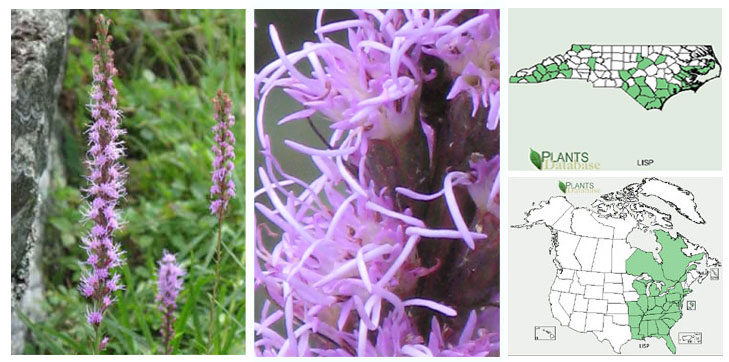

Habitat of Liatris spicata (Photo: Krings)

Habit of Liatris spicata (Photo: Krings)

Stem of Liatris spicata (Photo: Krings)

Leaves of Liatris spicata (Photo: Krings)

Habit of Liatris spicata (Photo: Krings)

Stem closeup of Liatris spicata (Photo: Krings)

Inflorescence of Liatris spicata (Photo: Krings)
Liatris spicata
(common; bogs, balds, seepages, savannas, roadsides; Mt, Pd, CP)
2'. Basal leaves 1-veined...3.
3. Apex of mid and inner involucral bracts acute, apiculate, or rounded-retuse and minutely involute-cuspidate...4.
4. Heads frequently secund; involucres 7–10 (–14) mm long, bracts obovate; florets 3–6...L. secunda 
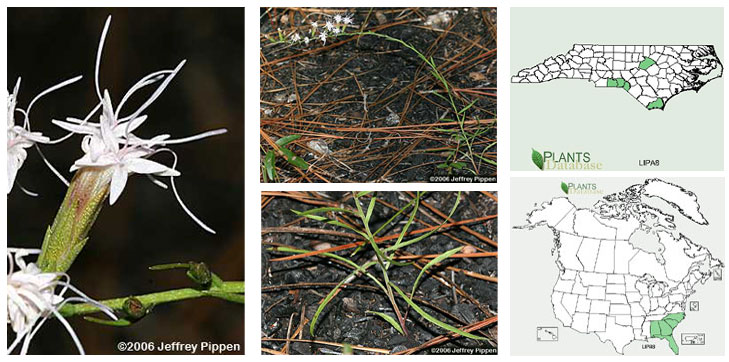

Habitat of Liatris secunda (Photo: Krings)

Habit of Liatris cokeri (Photo: Krings)

Leaves of Liatris secunda (Photo: Krings)

Habit of Liatris secunda (Photo: Krings)

Inflorescence of Liatris secunda (Photo: Krings)

Inflorescence of Liatris secunda (Photo: Krings)

Involucral bract of Liatris secunda (Photo: Krings)
Liatris secunda
(common; sandhills, CP)
4'. Heads secund or not; involucres 6–7 (–9) mm long, bracts ovate-triangular to oblong; florets 4–10 (–12)...5.
5. Basal leaves gradually reduced in length distally; heads frequently secund, involucral bracts distinctly
involute...L. cokeri 
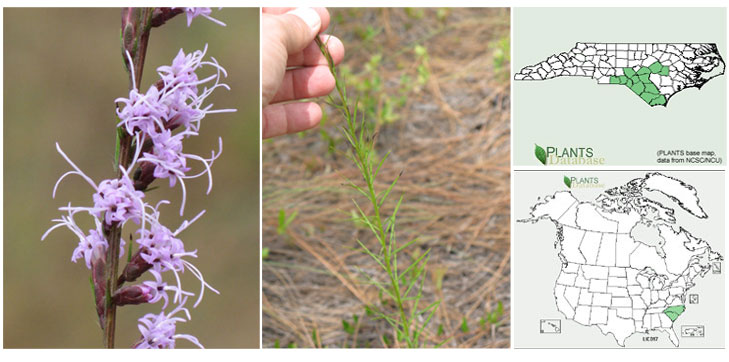

Habitat of Liatris cokeri (Photo: Krings)

Habit of Liatris cokeri (Photo: Krings)

Stem of Liatris cokeri (Photo: Krings)

Leaf of Liatris cokeri (Photo: Krings)

Liatris cokeri (Photo: Krings)

Inflorescence of Liatris cokeri (Photo: Krings)

Inflorescence of Liatris cokeri (Photo: Krings)
Liatris cokeri
(common; sandhills; CP)--
Liatris cokeri can easily be confused with
L. secunda, as both frequently display secund
inflorescences and co-occur.
Liatris cokeri exhibits phyllaries that
are oblong, whereas
L. secunda exhibits phyllaries
that are obovate. Stucky & Pyne (1990) noted that the corollas of
L. cokeri are evidently pubescent
within, at least
toward the base, whereas they are glabrate to glabrous in
L. secunda.
5'. Basal leaves quickly reduced in width and length distally; heads not secund, involucral bracts not markedly involute...L. virgata 
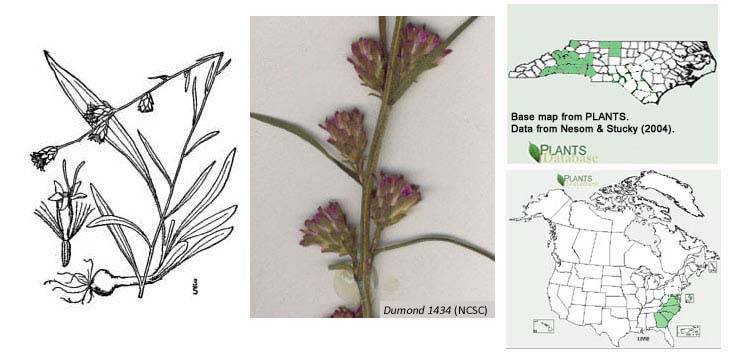 Liatris virgata
Liatris virgata
(common; open woods and roadsides; Mt, Pd)
3'. Apex of mid and inner involucral bracts rounded, but neither rounded-retuse nor cuspidate nor apiculate...6.
6. Stems glabrous (rarely sparsely to moderately pilose in L. pilosa)...7.
7. Corolla tubes glabrous within...L. microcephala 
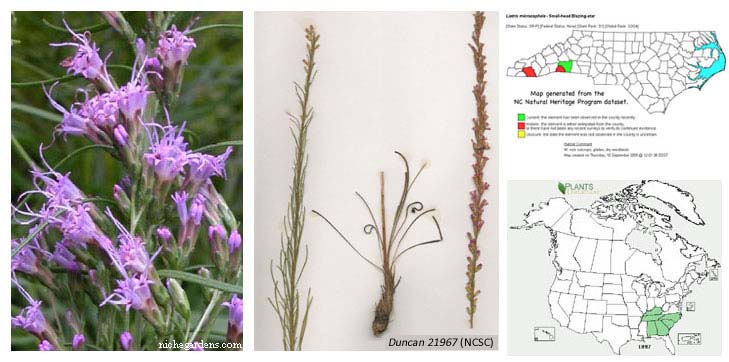 Liatris microcephala
Liatris microcephala
(rare [State SC-V, S1 G3G4]; acidic rock outcrops; Mt, Pd)
7'. Corolla tubes pilose within...8.
8. Stems 15–55 cm; leaves and phyllaries not at all punctate-glandular or weakly
so, the punctations evident only as tiny black dots (no glandular hairs evident); involucres 6–8(–10) mm wide; pappus bristles 1/2–2/3 to equal the the corolla tube length; Mt (cliffs and outcrops; 650–1600(–1850) m)...Liatris helleri* s.l. (incl. L. turgida) 
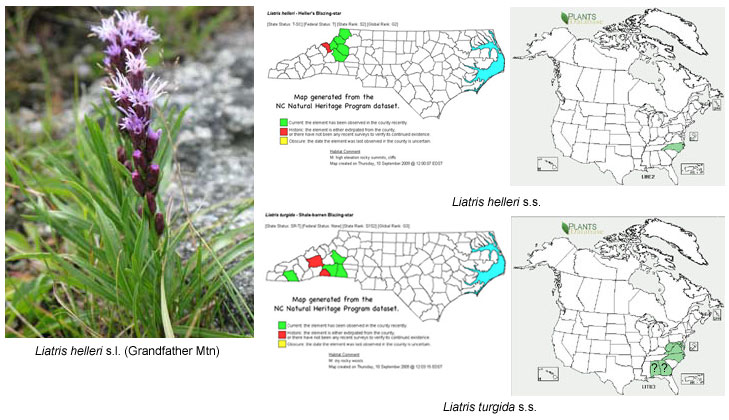

Habitat of Liatris helleri (Photo: Krings)

Habit of Liatris helleri (Photo: Krings)

Habit of Liatris helleri (Photo: Krings)

Basal leaves of Liatris helleri (Photo: Krings)

Involucral bracts of Liatris helleri (Photo: Krings)

Inflorescence of Liatris helleri (Photo: Krings)

Inflorescence of Liatris helleri (Photo: Krings)
L. helleri*
s.l.
(rare [Fed T, S2 G2]; cliffs and outcrops at high elevations; Mt; late summer to early fall)
8'. Stems 40–120 cm; leaves and phyllaries usually weakly punctate-glandular, phyllaries
sometimes eglandular or the glands weakly developed and superficial; involucres 5–6 mm wide; pappus bristles equal the corolla tube length; Pd, CP (sandhills, pine barrens roadsides; (0–)10–500 m)...L. pilosa 
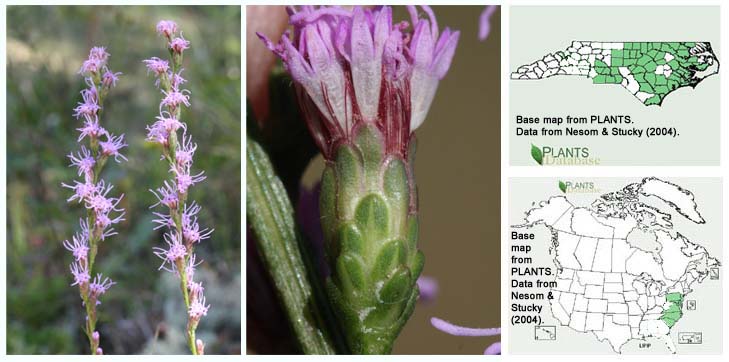

Habitat of Liatris pilosa (Photo: Krings)

Habit of Liatris pilosa (Photo: Krings)

Stem of Liatris pilosa (Photo: Krings)

Leaves of Liatris pilosa (Photo: Krings)

Inflorescence of Liatris pilosa (Photo: Krings)

Inflorescence of Liatris pilosa (Photo: Krings)

Inflorescence of Liatris pilosa (Photo: Krings)
Liatris pilosa
(common; sandhills, pine barrens, roadsides; Pd, CP)
6'. Stems puberulent to strigose...9.
9. Involucral bracts bullate, border conspicuous, broad, hyaline, frequently erose to lacerate...L. aspera 
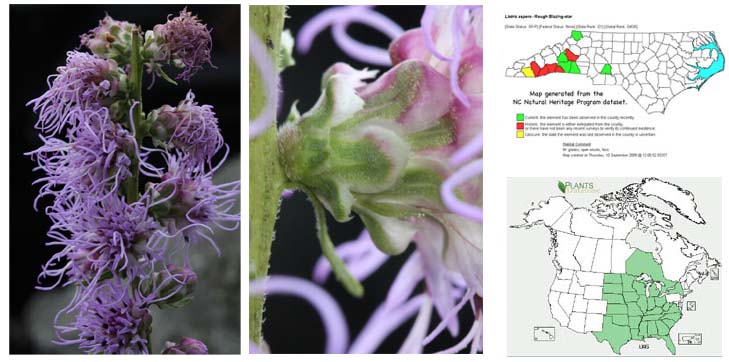

Habitat of Liatris aspera (Photo: Krings)

Habit of Liatris aspera (Photo: Krings)

Basal leaves of Liatris aspera (Photo: Krings)

Cauline leaves of Liatris aspera (Photo: Krings)

Inflorescence of Liatris aspera (Photo: Krings)

Heads and corollas of Liatris aspera (Photo: Krings)

Fruiting heads of Liatris aspera. Note the pubescent inflorescence axis (Photo: Krings)
Liatris aspera
(rare [State T, S1 G4G5]; prairies, barrens, glades; Mt, Pd?)
9'. Involucral bracts not bullate...10.
10. Involucres (12–) 15–22(–25) mm wide; florets 19–80...L. scariosa 
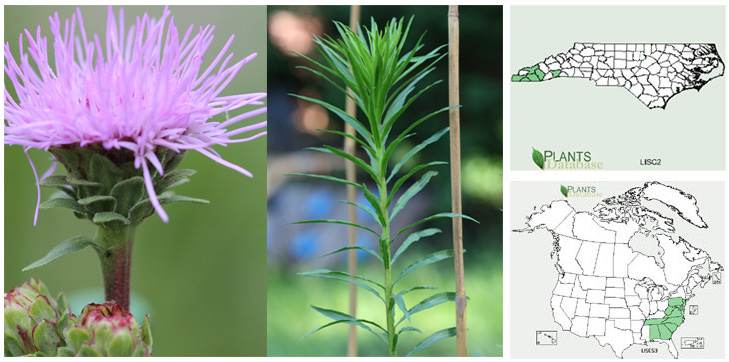 Liatris scariosa
Liatris scariosa
(rare? [NC Watch list]; shale barrens, outcrops; Mt)
Note: (1) Photos above are for garden-grown var.
nieuwlandii, but NC map is for var.
scariosa. In Weakley (2015), the
two are distinguished by number of leaves below the capitulescence (20-85 in var.
niewulandii vs. 8-20(25) in var.
scariosa) and floret number (ca. 30-80 in var.
nieuwlandii vs. 19-33 in var.
scariosa).
(2) The taxonomy of the
complex including
L. scariosa, its varieties, as well as
L. squarrulosa, has not been resolved
with satisfaction. Additional
field and genetic work is required; circumscriptions may change in the future.
10'. Involucres (6–) 8–15 mm wide; florets 11–26 (–28)...L. squarrulosa 


Basal leaves of Liatris squarrulosa (Photo: Krings)

Stem leaves of Liatris squarrulosa (Photo: Krings)

Stem leaves of Liatris squarrulosa (Photo: Krings)

Inflorescence of Liatris squarrulosa (Photo: Krings)

Head of Liatris squarrulosa (Photo: Krings)

Head of Liatris squarrulosa (Photo: Krings)

Corollas of Liatris squarrulosa (Photo: Krings)
Liatris squarrulosa
(rare [State SR, S2 G4G5]; diabase barrens, glades, and open woodlands; Mt, Pd, CP)











